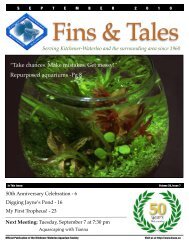April 2009 - Kitchener Waterloo Aquarium Society
April 2009 - Kitchener Waterloo Aquarium Society
April 2009 - Kitchener Waterloo Aquarium Society
You also want an ePaper? Increase the reach of your titles
YUMPU automatically turns print PDFs into web optimized ePapers that Google loves.
from dwarves that will grow 18 inches deep with a coverage of<br />
2 or 3 square feet to monsters that can be potted 4 feet below the<br />
surface and cover a surface area of 25-30 square feet or more.<br />
Most lilies purchased are hardy but there are also tropical<br />
species available. They are often more vibrant in colour and<br />
may be fragrant. Another twist is that there are night blooming<br />
tropical lilies that can be interesting. These are usually one<br />
season specimens as they are difficult to keep over the winter<br />
without adequate space and lighting needs but are worth a try<br />
for something different.<br />
Lilies serve another important purpose in the pond. They are<br />
very heavy feeders – as in, they absorb large amounts of<br />
nutrients from the water. Many people will worry and complain<br />
about the amount of algae in their ponds early in the season.<br />
This is a natural cycle as there is fresh water in the pond, heavy<br />
in nutrients in the spring, with very little plant life ready to<br />
absorb these nutrients. An algae bloom takes place until either<br />
the nutrients are used up or other sources compete for them. As<br />
lilies are heavy feeders, once they become active they will suck<br />
up those extra nutrients and compete with algae and the pond<br />
will stabilize and the algae will subside more quickly. To help<br />
produce more flowers you can add fertilizers tabs into the pots<br />
near the roots but I have found that once lilies become<br />
acclimated, fertilizing is not something you need to worry<br />
about.<br />
Hardy lilies have a long life and are very easy to propagate.<br />
They have a large rhizome than can get quite thick and woody.<br />
A potted plant can be pulled out and the rhizome chopped and<br />
cut and any place there is an eye it will send out a stem. I have<br />
grown plants that became so large and thick that the whole<br />
weighted pot started floating because there was so much<br />
floating plant growth. The leaves of a water lily will provide<br />
very good shade for fish and other pond life. The leaves will<br />
often have varied colours and patterns on them as well and can<br />
be quite attractive. Keep them away from fountains or<br />
waterfalls as the leaves do not want to be constantly wet on top<br />
once they have developed into surface growth. Many fish will<br />
like to use the undergrowth for hiding and spawning as well<br />
A P R I L 2 0 0 9<br />
and of course if you have frogs in the pond they will use the<br />
leaves as their own personal tanning beds.<br />
Water lotus fall under the same species name as water lilies and<br />
are quite similar. Plants tend to grow from bulbs or tubers<br />
instead of rhizomes though. There are tropical and hardy<br />
versions of water lotus to be found and even the aquarium<br />
version of the red tiger lotus can be grown outdoors during the<br />
summer.<br />
Oxygenating Plants<br />
These plants are placed into the pond to provide a gas exchange<br />
for the fish being kept much like we were taught way back in<br />
the dark ages of aquarium keeping (I’m certain that some of<br />
you can remember reading that in an old scroll or tome<br />
somewhere). The good thing is that most of us have all seen or<br />
heard of many of these plants already and may have them in<br />
our tanks. Many are North American species or have come from<br />
other parts of the world and will manage to overwinter in a<br />
pond that does not freeze solid to the bottom. This makes the<br />
plants perennial varieties that don’t have to be replaced each<br />
year (unless of course the fish enjoy them a little too much and<br />
chew them down to nothing). Most of these plants will also<br />
provide cover for small fish to hide in and will make very good<br />
spawning mops for goldfish and koi or whatever fish may be in<br />
the pond. When using these in a pond it is best to plant them in<br />
a pot with some pond soil and fill the top with stone or gravel<br />
to keep fish from uprooting or tearing them apart. While most<br />
of these plants will winter, many people will harvest them in<br />
the fall. Please be wary and careful when doing so. If you put<br />
them directly into an aquarium there are several pitfalls that<br />
you may be dealing with. For one by the time you bring it in at<br />
the end of the season most plants will have acclimated to cooler<br />
temperatures. Putting them into a heated aquarium will shock<br />
them and very often kill them. Additionally, many varieties of<br />
parasites and diseases will piggyback along with them as well<br />
and plants are better quarantined for a while. Snails, insect<br />
larvae and even predatory insects could get into your aquarium<br />
and cause havoc. Also keep this in mind when bundling things<br />
up for those fall auctions. Quarantine, quarantine quarantine!<br />
Ceratophylum demersum (hornwort)<br />
Yes, this is the ever popular and simple plant that we all know<br />
and love for saving our livebearer fry and it works in the pond<br />
too. Hornwort will overwinter and come back each year to<br />
provide shelter and oxygen. You may even need to pull out<br />
excess plant material a few times a season as it will get a bit too<br />
thick. It will often grow heavier in a pond and sit near the<br />
bottom rather than all floating as we are used to. This is both a<br />
very inexpensive and handy plant.<br />
Vallisneria species<br />
There are many varieties of vals that can be grown in a pond.<br />
Giant (gigantean), Italian (spiralis) and corkscrew (americana)<br />
all are good choices. These will grow and propagate just as they<br />
9














